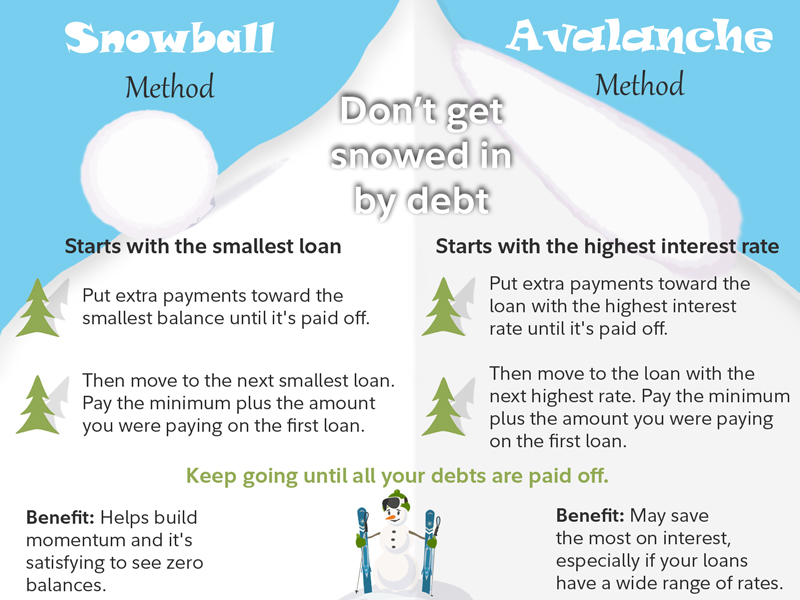If you're juggling multiple debts, paying them down can be a huge relief. Reducing your debt load can help you save on interest and free up money for financial goals—from education to a home purchase to retirement.
Making extra payments, above the minimum requirement, on your debts is one way to help get yourself out of the hole, in addition to potentially using other methods of easing your debt burden—like refinancing, consolidating, or possibly forbearance or deferment. To make the most of your extra payments, consider using one of these strategies: the debt snowball method or the debt avalanche method.

What is the debt avalanche method? Higher rate, higher priority
The debt avalanche method generally saves you the most on interest payments, particularly if you have loans with a wide range of interest rates. It may also help you pay off your loan faster. That’s because you tackle the loans with the biggest interest rates first. It's like an avalanche because as you pay off debts, you put all of the money you were paying toward your previous debt into the next one in line. By the time you get to the end, you may be putting so much money toward your final debt it's like an avalanche careening down a mountain toward that loan. Here's how you put it into action:
|
Visit the Fidelity debt toolLog In Required to sort your debts by interest rate or balance.
Imagine you had the following hypothetical scenario.
| Balance | Interest rate | Minimum payment | ||||
|---|---|---|---|---|---|---|
| Loan 1 | $20,000 | 20% | $450 | |||
| Loan 2 | $100,000 | 6% | $1,000 | |||
| Loan 3 | $10,000 | 3% | $100 | |||
| For illustrative purposes only. | ||||||
With no extra payments or strategy for paying the loans off, you could be looking at paying $57,249 in interest and would be making payments for about 12 years. Say you could put an extra $100 per month toward your debts after making your minimum payments: You'd boost your monthly payment on Loan 1 from $450 to $550. That extra payment would shave 2 years off your payoff time on that loan and save more than $5,750 in interest—just on that single loan.
Next you'd add that $550 to the $1,000 minimum payment on Loan 2. When you'd paid off that loan, you'd devote all your loan-payment money—$1,550 per month—to Loan 3.
The total interest paid would be about $45,340—nearly $12,000 less than just paying the minimums and you would pay off your debt in 9 years instead of 12.
This assumes your interest rate doesn't change and the minimum required payment never changes as well—in these hypothetical scenarios, the only time the amount paid changes is when more money is put toward the loan.
There are additional considerations if you have very low interest rate debts and have other long-term financial priorities. In those cases, it can make sense to compare your interest costs versus the potential of compounding returns on money invested. Read Viewpoints on Fidelity.com: How to pay off debt—and save too
If you want more immediate gratification, consider the snowball method. It may not save you quite as much on interest, but it will reduce your number of debts more quickly.
What is the debt snowball method?
Attack smaller balances first
With this strategy you start by listing your debts by balance size, with the smallest at the top and the largest at the bottom. For example:
| Balance | Interest rate | Minimum payment | ||||
|---|---|---|---|---|---|---|
| Loan 3 | $10,000 | 3% | $100 | |||
| Loan 1 | $20,000 | 20% | $450 | |||
| Loan 2 | $100,000 | 6% | $1,000 | |||
| For illustrative purposes only. | ||||||
As you pay off smaller debts, the amount of money you can put toward larger balances grows like a snowball rolling down a hill.
In this example, your interest cost would be about $51,000 by applying that extra $100 to the lowest balance first and then working through the rest of your debts. Your interest savings over making the minimum payment would be about $6,240 and you'd be making payments for 10 years.
This scenario also assumes that the interest rate and required minimum payment stay the same through the life of the loan. In these examples, the amount paid only changes when extra money is paid toward the loan.
The debt snowball method doesn't save as much on interest as the debt avalanche method, because it doesn't pay down higher-rate balances as quickly. But research suggests that for many people, focusing on the smallest debts first may be the most effective way to become debt-free. The reason: Clearing smaller debts quickly shows progress, helping build positive momentum.
The avalanche method doesn't always save a lot more money in interest. “If you are in a situation where you have high interest loans, avalanche may be most appropriate. But if all of your loans are similar or all have lower interest rates, the method may not be much more efficient than the snowball approach,” says Mike Rusinak, CFP®, a vice president in the Financial Solutions Team at Fidelity.
It could make sense to do the math, or use an online calculator, and see which strategy could work best for your situation. One more thing to note before you pick a strategy for tackling debt: Check to make sure your loans don't have a pre-payment penalty. (Thankfully, fees for paying off a debt early are rare these days.)
Eliminating debt feels great, and it frees up money for you to save and invest for your future. As you pay off debts, consider using your new cash flow to build an emergency savings worth 3 to 6 months' of essential expenses—so you can be confident that you'll be able to avoid taking on new debt in the future.


